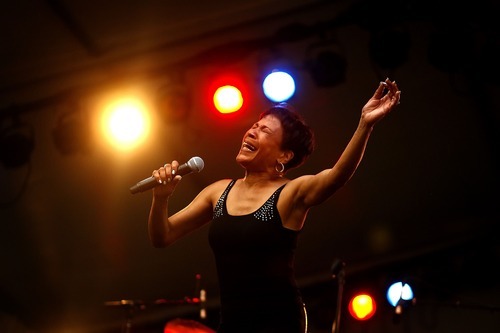This is an archived article that was published on sltrib.com in 2012, and information in the article may be outdated. It is provided only for personal research purposes and may not be reprinted.
Cows have four stomachs. Alas, humans have only one.
So once you get your fill from one of the 21 food booths at the annual Living Traditions Festival on the grounds of the Salt Lake City & County Building this weekend, get more sustenance from the performers.
The festival spotlights music, dance, crafts and foods of the city's ethnic communities, with featured evening performances by national headliners on the North Stage.
• French and Chilean rapper Ana Tijoux will perform Friday, May 18, at 7 p.m.
• Punchy genre-bending ensemble Mexican Institute of Sound will perform Friday, May 18, at 8:30 p.m.
• R&B firecracker Bettye LaVette will perform Saturday, May 19, at 8:30 p.m.
• Chicago harmonica master and bandleader Charlie Musslewhite will perform Sunday, May 20, at 5:30 p.m.
LaVette and Musselwhite are legendary American traditionalists, but this year's headliners also include lesser-known acts from Chile and Mexico that use traditional sounds to explore the future of modern music, said Casey Jarman, founder and director of the Living Traditions Festival.
For example, the Mexican Institute of Sound blends traditional cumbia — a genre rooted in Latin American folk that often includes accordions and guitars — with electronic-dance elements such as samples from N.W.A. and De La Soul.
In addition, Jarman said he booked Tijoux to help listeners hear that rap and hip-hop aren't entirely American-grown, and that accents from other cultures deepen our appreciation of multiculturalism.
Tijoux and Musselwhite talked to The Tribune about how they make modern sounds
Ana Tijoux • While some consider Tijoux among the best Spanish-language rappers, she grew up in France.
But her ties to her homeland of Chile always remained strong. Her Chilean parents were exiled to France during the military dictatorship of Augusto Pinochet, whose 1973 coup d'état overthrew Chile's democratically elected socialist government.
Once she returned to Chile, she was an integral part of the pioneering hip-hop group Makiza until she decided to go solo. Her style is unique; listeners can hear influences from the early 1980s rap of New York artists such as Melle Mel, Rakim and Kool Moe Dee.
Tijoux said she used her love of old-school rap, James Brown, John Coltrane and funk to fuse her flow, along with French and Chilean influences. "Everything can be inspiring," she said. "Traditional or nontraditional, anything can be an inspiration."
Charlie Musselwhite • The 68-year-old blues harmonica master and bandleader said if he had been born in Salt Lake City, he wouldn't be who he is today.
"You're a product of your environment," he said. If he had been born in Utah, he wouldn't have learned the blues from the masters he met and befriended in Chicago — unless "there might be an unknown blues history [in Salt Lake City] I'm not aware of."
Born in Kosciusko, Miss., with American Indian ancestry, Musselwhite moved to Chicago to look for factory jobs. "The first blues I heard in Chicago was when I was in search of a job with benefits," he said. "I was looking for a job, walking in Old Town, and I heard a piano coming from the basement. It was Little Brother Montgomery."
Hearing Montgomery's music was life-changing. Musselwhite got a job as a driver for an extermination company, whose services proved much-needed in blues clubs of the era. "That was great, because I learned about all the blues clubs around town," he said. "I was like a kid in a candy store in Chicago."
Inducted into the Blues Hall of Fame in 2010, Musselwhite said influences such as Furry Lewis and Will Shade have stayed with him all his life. "I've been playing traditional American music in a modern way," he said. "There are new ways of being traditional. It's alive. It's not an antique. Blues is not a fad — it's life."
Facebook.com/sltribmusic
Twitter: @davidburger —
2012 Living Traditions Festival
The 27th annual festival will celebrate Salt Lake City's folk and ethnic arts, with music and dance performances, as well as food and craft booths.
When • Friday, May 18, 5-10 p.m.; Saturday, May 19, noon to 10 p.m.; Sunday, May 20, noon to 7 p.m.
Where • Salt Lake City & County Building, 451 S. State St., Salt Lake City
Tickets • Free admission
Schedule • For the full slate of local performing groups, visit http://www.livingtraditionsfestival.com. The schedule is listed by day, as well as alphabetically by performer.
Info • For the first time in the festival's history, craft artists will be able to sell their crafts at their own booths, rather than forcing patrons to go to a separate craft shop. The experiment is aimed at creating a deeper connection between the artists and patrons, according to director Casey Jarman.
New this year • Performances from the Nepalese Association of Utah and Pajaros and Pintados; craft artists East Indian henna, global artisans, Maori-inspired pottery, Mexican Day of the Dead art, American Indian silversmithing, Shoshone beadwork, Somali Bantu baskets; and among the ethnic food booths, Turkish, Nepalese and soul food will be offered for the first time.



